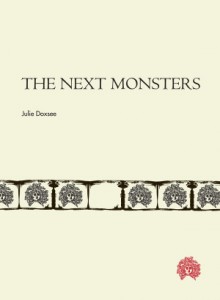Book Review
 Julie Doxsee’s new hybrid genre collection, The Next Monsters, presents the reader with a provocative defamiliarization of everyday objects, domestic spaces, and even language itself. This beautifully crafted book uses seemingly familiar diction and imagery—for instance, a “black t-shirt,” “a mirror,” “a cardboard box”—as points of entry to compelling questions about the expectations that we as readers bring to prose: Why does one expect the meaning of even the most commonplace words to remain consistent throughout various literary and cultural texts? What larger structures of power and authority govern the ways language is used? And perhaps most importantly, how can the meanings that we attach to words, phrases, and even cultural artifacts be questioned and revised? As Doxsee poses tentative hypotheses, her work presents readers with a graceful matching of style and content, as her most subtle technical choices illuminate the text itself.
Julie Doxsee’s new hybrid genre collection, The Next Monsters, presents the reader with a provocative defamiliarization of everyday objects, domestic spaces, and even language itself. This beautifully crafted book uses seemingly familiar diction and imagery—for instance, a “black t-shirt,” “a mirror,” “a cardboard box”—as points of entry to compelling questions about the expectations that we as readers bring to prose: Why does one expect the meaning of even the most commonplace words to remain consistent throughout various literary and cultural texts? What larger structures of power and authority govern the ways language is used? And perhaps most importantly, how can the meanings that we attach to words, phrases, and even cultural artifacts be questioned and revised? As Doxsee poses tentative hypotheses, her work presents readers with a graceful matching of style and content, as her most subtle technical choices illuminate the text itself.
Doxsee’s work is at its best when familiar words and phrases take on unfamiliar semiotic meanings. As The Next Monsters unfolds, one discovers that commonplace linguistic constructions no longer mean what one thinks they do. The fact that Doxsee undermines the expectations that we bring to even seemingly transparent language makes us suddenly aware of our normative ideas about what communication should be like. Consider “Lightning”:
Sometimes I hope for new blood while trying to start my birthday. Any suit of yours I slip into is a nice birthday.
Here the meaning of the word “birthday” is completely transformed, as it no longer retains any discernible connection to temporality. Indeed, the speaker’s “birthday” seems at times to be an object, and at other moments, a mere state of mind. What’s remarkable about this passage is Doxsee’s ability to affix multiple, and often contradictory, meanings to what was once a familiar turn of phrase. By doing so, Doxsee suggests the arbitrariness of the relationship between the signifier and what’s being signified. I find it fascinating that Doxsee’s book invents its own lexicon, one marked by contradictions, unpredictability, and an inherent instability. By doing so, she suggests that a single word can house a proliferation of meanings if we allow it to.
Doxsee’s work also utilizes familiar grammatical constructions, yet within these seemingly pristine sentences, we see a provocative fragmentation of meaning. Although each sentence appears to follow the rules of grammar, complete with dependent clauses and diligent punctuation, the words themselves seem incongruous, mismatched. Doxsee subtly and artfully questions the most basic cultural assumptions about what it means for a text to be “legible.” In my opinion, this gesture also raises thought-provoking questions about the role of grammar in regulating thought and expression. She writes, for instance, in “Moustache”:
I was in love with a mustache. We ate fried mussels and hid under a winter coat in the monster cold. It made me wear big jewelry that caught the light nicely. It wanted me to coat my walls orange so I did. When it hovered in the streets, the streets became wavy and steep.
Here Doxsee shows us, though her artful misuse of proper grammar, that the rules we as a culture affix to language limit our thinking. Poems like “Moustache” suggest that grammatical conventions render certain expressions, juxtapositions, and narratives nearly impossible to articulate. A reader would likely wonder what this passage would be like if rendered as a painting or film. Given the montage-like quality of the imagery, one certainly can see Doxsee striving to adapt the techniques of other arts to poetry. When placed in the form of a traditional sentence, however, the narrative is rendered “illegible.”
For me, this incisive interrogation of what it means for a text to be legible is one of the most compelling questions raised by the book. Doxsee calls our attention to the structures of power and authority that regulate grammar, linguistic convention, and the various definitions of “coherence” that circulate within our culture. What’s more, Doxsee communicates these larger questions about language, culture, and society through her subtle stylistic choices. Her book quite beautifully uses form as an extension of content, as her sentence-level choices convey ambitious and insightful questions about the world around her.
In short, Doxsee’s The Next Monsters is an accomplished volume, one that’s as carefully crafted as it is culturally astute. Her new collection is a wonderful addition to an already thought-provoking body of work.
Posted May 14, 2014
About the Reviewer
Kristina Marie Darling is the author of sixteen books, which include Melancholia (An Essay) (Ravenna Press, 2012), Petrarchan (BlazeVOX Books, 2013), and a forthcoming hybrid genre collection called Fortress (Sundress Publications, 2014). Her awards include fellowships from Yaddo, the Helene Wurlitzer Foundation, and the Hawthornden Castle International Retreat for Writers, as well as grants from the Kittredge Fund and the Elizabeth George Foundation. She is currently working toward a Ph.D. in Poetics at S.U.N.Y.-Buffalo.